Communication Skills for Nurses and Midwives: Patient Education
VerifiedAdded on 2023/01/05
|6
|1149
|86
Report
AI Summary
This report provides a comprehensive overview of patient education within the context of nursing and midwifery. Part 1 defines patient education as the process of informing patients about their ailments to improve their understanding and adherence to treatment plans. It also discusses two key challenges: difficulties in communication and insufficient knowledge and skills among nurses. Part 2 explores strategies for nurses to improve patient discharge medication education, emphasizing the IDEAL strategy (Include, Discuss, Educate, Assess, Listen) to ensure patients and their families are fully informed and supported during the transition from hospital to home. The report highlights the crucial role of effective communication and patient-centered approaches in enhancing healthcare outcomes.
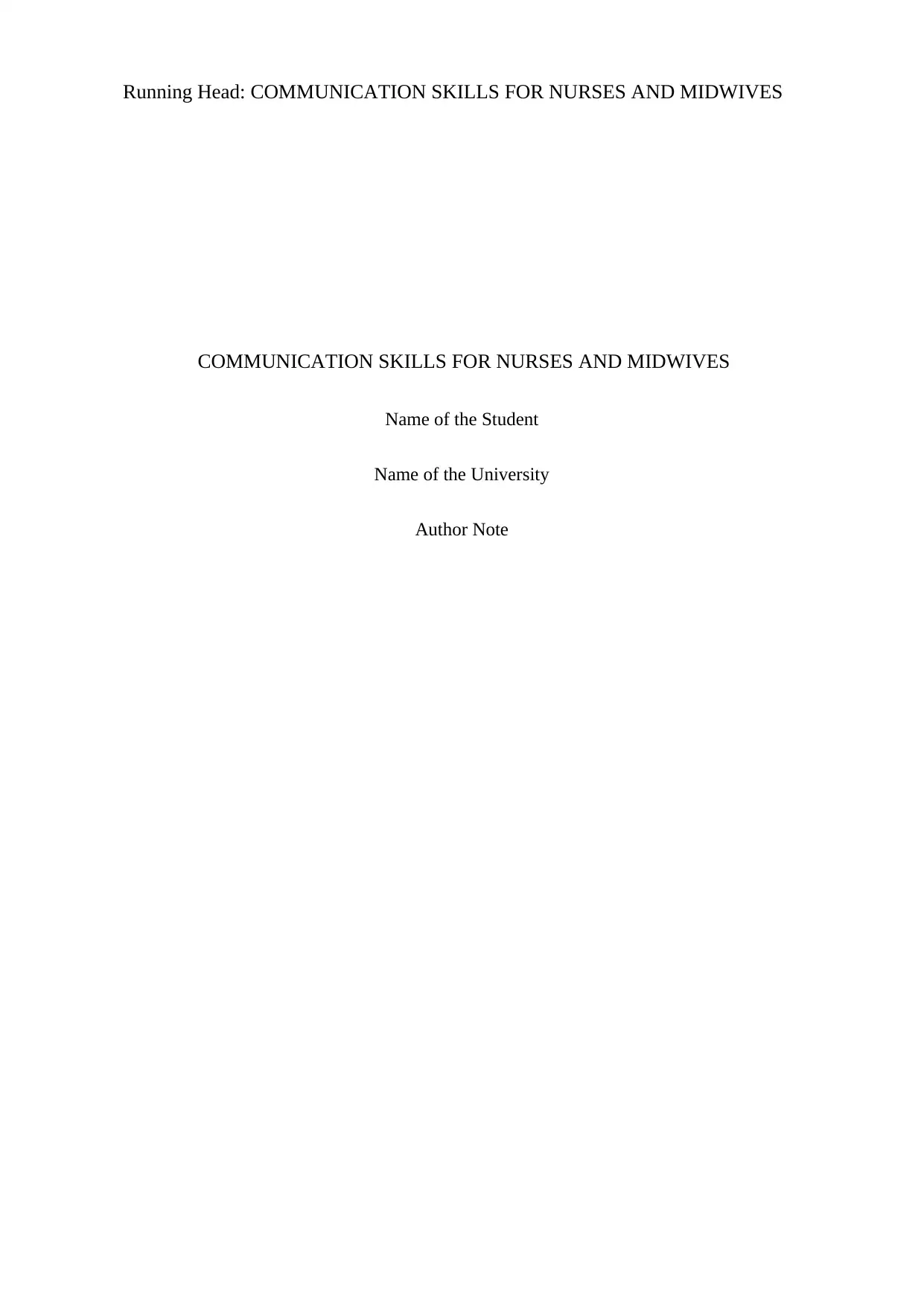
Running Head: COMMUNICATION SKILLS FOR NURSES AND MIDWIVES
COMMUNICATION SKILLS FOR NURSES AND MIDWIVES
Name of the Student
Name of the University
Author Note
COMMUNICATION SKILLS FOR NURSES AND MIDWIVES
Name of the Student
Name of the University
Author Note
Paraphrase This Document
Need a fresh take? Get an instant paraphrase of this document with our AI Paraphraser
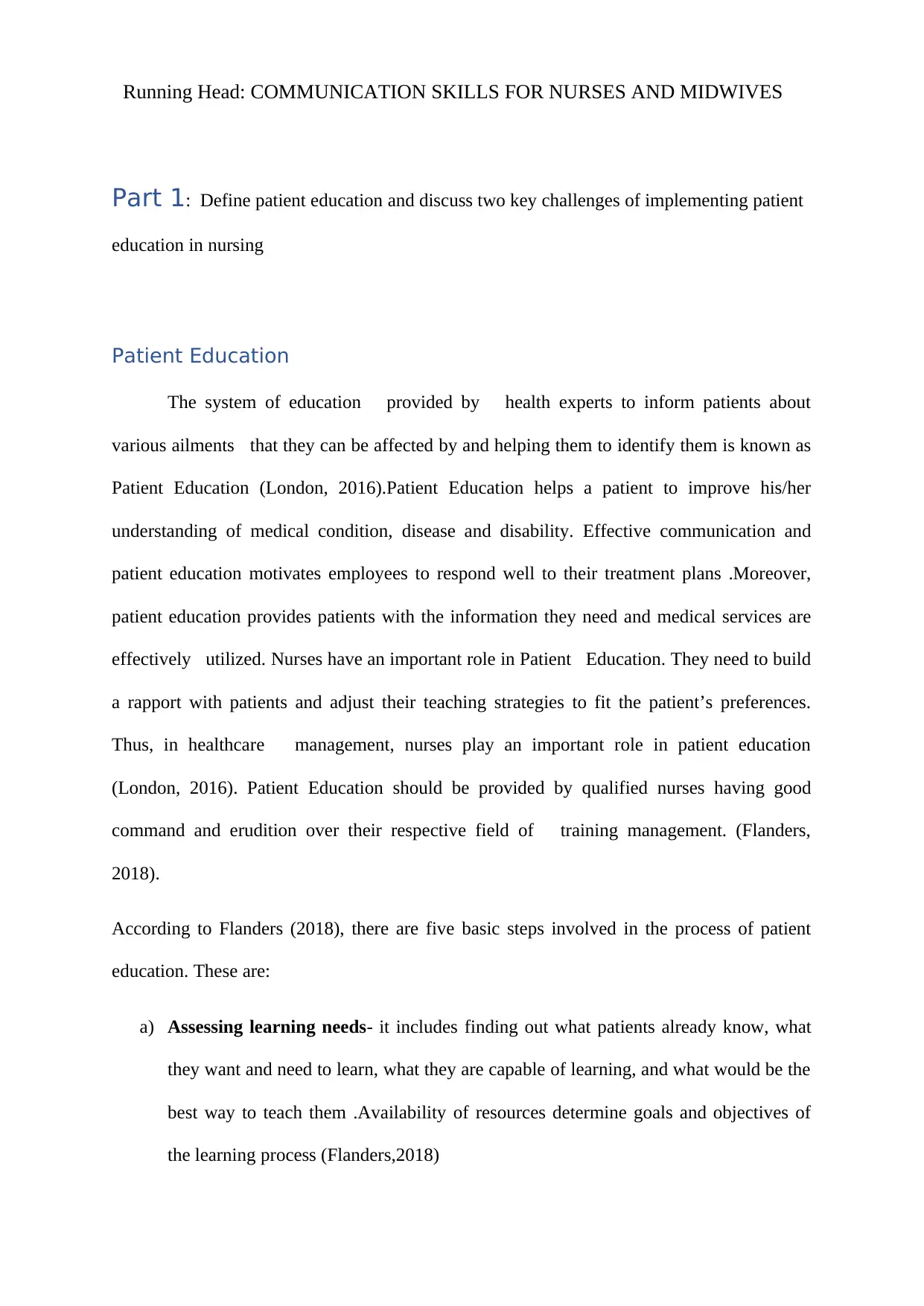
Running Head: COMMUNICATION SKILLS FOR NURSES AND MIDWIVES
Part 1: Define patient education and discuss two key challenges of implementing patient
education in nursing
Patient Education
The system of education provided by health experts to inform patients about
various ailments that they can be affected by and helping them to identify them is known as
Patient Education (London, 2016).Patient Education helps a patient to improve his/her
understanding of medical condition, disease and disability. Effective communication and
patient education motivates employees to respond well to their treatment plans .Moreover,
patient education provides patients with the information they need and medical services are
effectively utilized. Nurses have an important role in Patient Education. They need to build
a rapport with patients and adjust their teaching strategies to fit the patient’s preferences.
Thus, in healthcare management, nurses play an important role in patient education
(London, 2016). Patient Education should be provided by qualified nurses having good
command and erudition over their respective field of training management. (Flanders,
2018).
According to Flanders (2018), there are five basic steps involved in the process of patient
education. These are:
a) Assessing learning needs- it includes finding out what patients already know, what
they want and need to learn, what they are capable of learning, and what would be the
best way to teach them .Availability of resources determine goals and objectives of
the learning process (Flanders,2018)
Part 1: Define patient education and discuss two key challenges of implementing patient
education in nursing
Patient Education
The system of education provided by health experts to inform patients about
various ailments that they can be affected by and helping them to identify them is known as
Patient Education (London, 2016).Patient Education helps a patient to improve his/her
understanding of medical condition, disease and disability. Effective communication and
patient education motivates employees to respond well to their treatment plans .Moreover,
patient education provides patients with the information they need and medical services are
effectively utilized. Nurses have an important role in Patient Education. They need to build
a rapport with patients and adjust their teaching strategies to fit the patient’s preferences.
Thus, in healthcare management, nurses play an important role in patient education
(London, 2016). Patient Education should be provided by qualified nurses having good
command and erudition over their respective field of training management. (Flanders,
2018).
According to Flanders (2018), there are five basic steps involved in the process of patient
education. These are:
a) Assessing learning needs- it includes finding out what patients already know, what
they want and need to learn, what they are capable of learning, and what would be the
best way to teach them .Availability of resources determine goals and objectives of
the learning process (Flanders,2018)
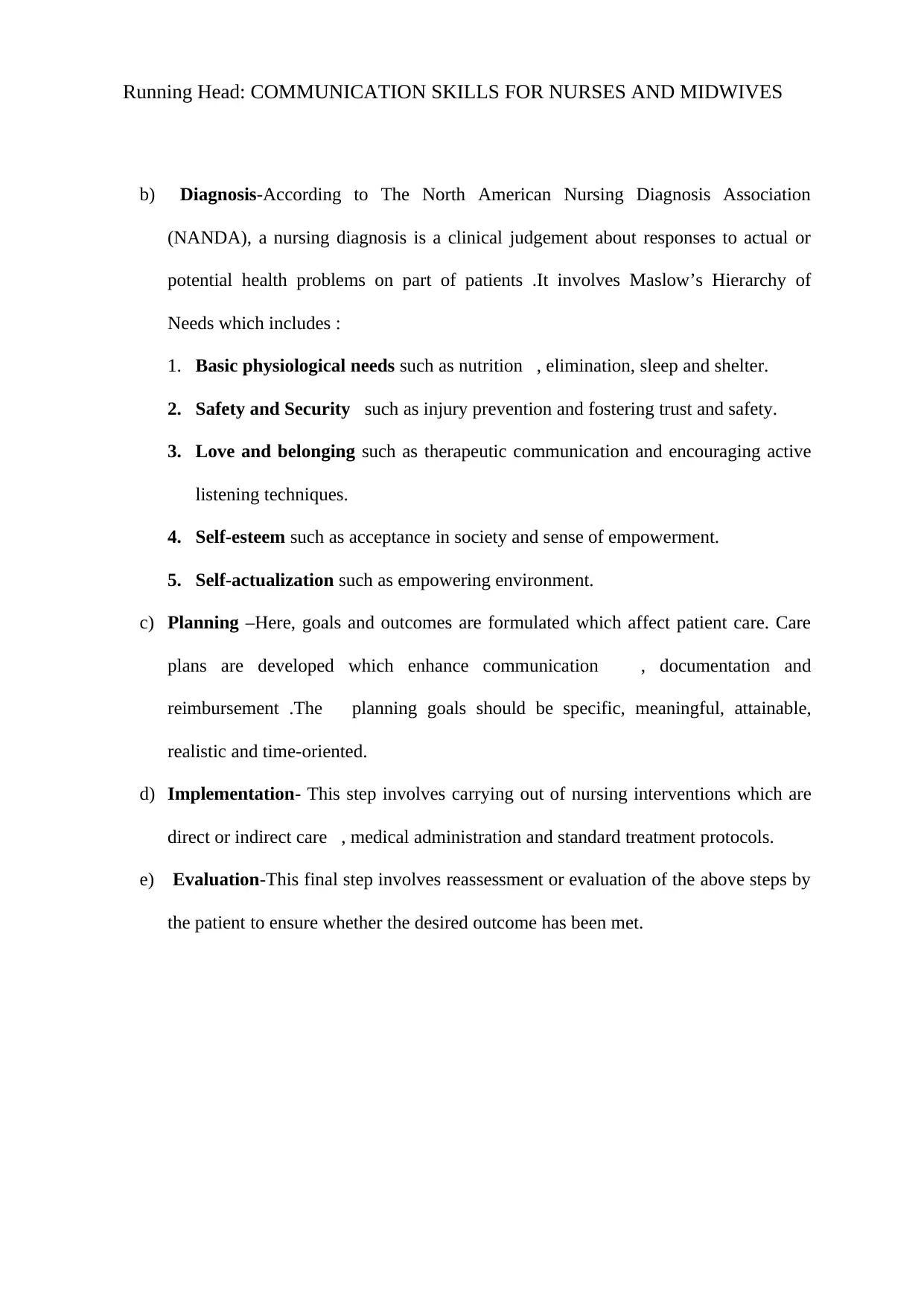
Running Head: COMMUNICATION SKILLS FOR NURSES AND MIDWIVES
b) Diagnosis-According to The North American Nursing Diagnosis Association
(NANDA), a nursing diagnosis is a clinical judgement about responses to actual or
potential health problems on part of patients .It involves Maslow’s Hierarchy of
Needs which includes :
1. Basic physiological needs such as nutrition , elimination, sleep and shelter.
2. Safety and Security such as injury prevention and fostering trust and safety.
3. Love and belonging such as therapeutic communication and encouraging active
listening techniques.
4. Self-esteem such as acceptance in society and sense of empowerment.
5. Self-actualization such as empowering environment.
c) Planning –Here, goals and outcomes are formulated which affect patient care. Care
plans are developed which enhance communication , documentation and
reimbursement .The planning goals should be specific, meaningful, attainable,
realistic and time-oriented.
d) Implementation- This step involves carrying out of nursing interventions which are
direct or indirect care , medical administration and standard treatment protocols.
e) Evaluation-This final step involves reassessment or evaluation of the above steps by
the patient to ensure whether the desired outcome has been met.
b) Diagnosis-According to The North American Nursing Diagnosis Association
(NANDA), a nursing diagnosis is a clinical judgement about responses to actual or
potential health problems on part of patients .It involves Maslow’s Hierarchy of
Needs which includes :
1. Basic physiological needs such as nutrition , elimination, sleep and shelter.
2. Safety and Security such as injury prevention and fostering trust and safety.
3. Love and belonging such as therapeutic communication and encouraging active
listening techniques.
4. Self-esteem such as acceptance in society and sense of empowerment.
5. Self-actualization such as empowering environment.
c) Planning –Here, goals and outcomes are formulated which affect patient care. Care
plans are developed which enhance communication , documentation and
reimbursement .The planning goals should be specific, meaningful, attainable,
realistic and time-oriented.
d) Implementation- This step involves carrying out of nursing interventions which are
direct or indirect care , medical administration and standard treatment protocols.
e) Evaluation-This final step involves reassessment or evaluation of the above steps by
the patient to ensure whether the desired outcome has been met.
⊘ This is a preview!⊘
Do you want full access?
Subscribe today to unlock all pages.

Trusted by 1+ million students worldwide
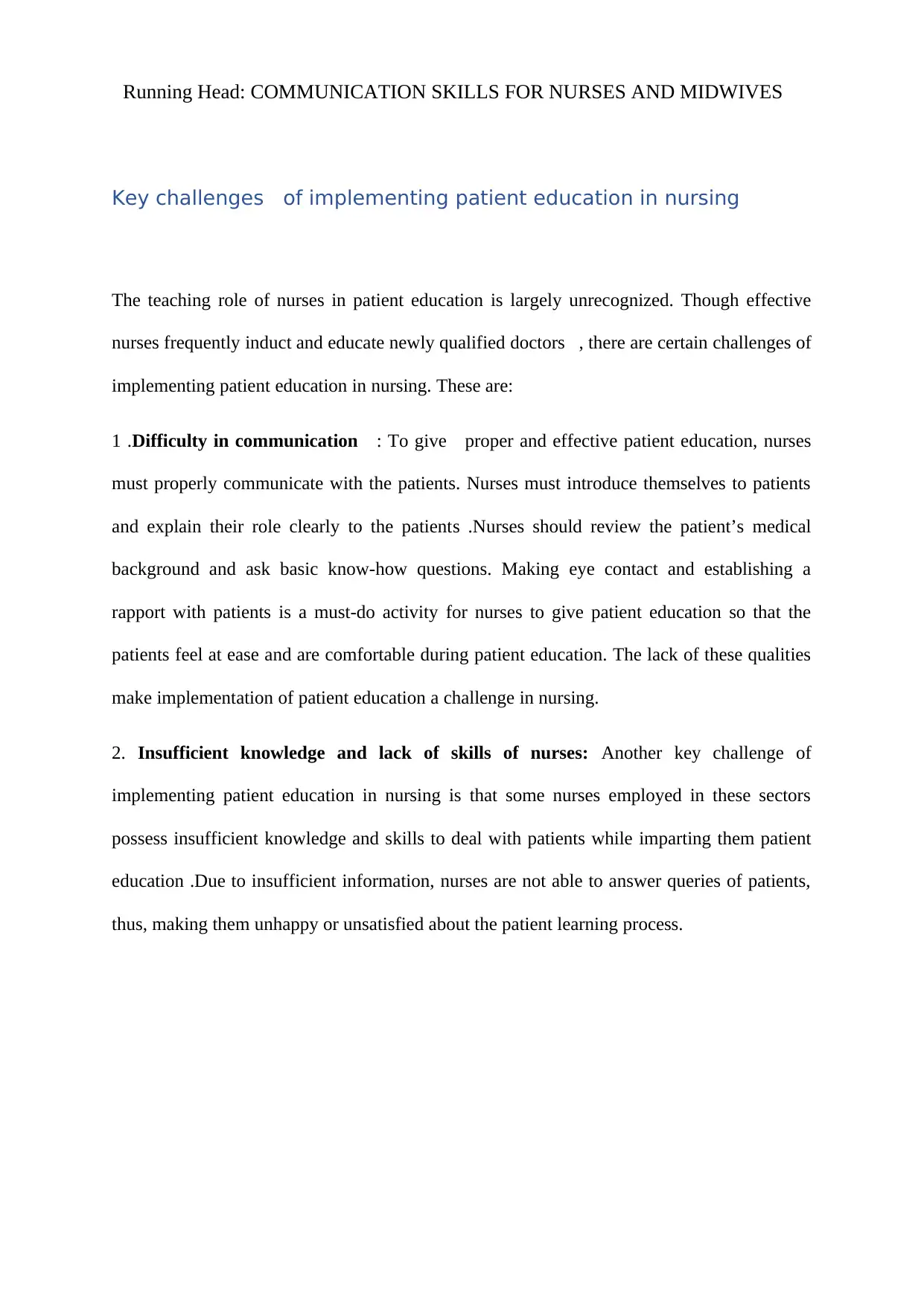
Running Head: COMMUNICATION SKILLS FOR NURSES AND MIDWIVES
Key challenges of implementing patient education in nursing
The teaching role of nurses in patient education is largely unrecognized. Though effective
nurses frequently induct and educate newly qualified doctors , there are certain challenges of
implementing patient education in nursing. These are:
1 .Difficulty in communication : To give proper and effective patient education, nurses
must properly communicate with the patients. Nurses must introduce themselves to patients
and explain their role clearly to the patients .Nurses should review the patient’s medical
background and ask basic know-how questions. Making eye contact and establishing a
rapport with patients is a must-do activity for nurses to give patient education so that the
patients feel at ease and are comfortable during patient education. The lack of these qualities
make implementation of patient education a challenge in nursing.
2. Insufficient knowledge and lack of skills of nurses: Another key challenge of
implementing patient education in nursing is that some nurses employed in these sectors
possess insufficient knowledge and skills to deal with patients while imparting them patient
education .Due to insufficient information, nurses are not able to answer queries of patients,
thus, making them unhappy or unsatisfied about the patient learning process.
Key challenges of implementing patient education in nursing
The teaching role of nurses in patient education is largely unrecognized. Though effective
nurses frequently induct and educate newly qualified doctors , there are certain challenges of
implementing patient education in nursing. These are:
1 .Difficulty in communication : To give proper and effective patient education, nurses
must properly communicate with the patients. Nurses must introduce themselves to patients
and explain their role clearly to the patients .Nurses should review the patient’s medical
background and ask basic know-how questions. Making eye contact and establishing a
rapport with patients is a must-do activity for nurses to give patient education so that the
patients feel at ease and are comfortable during patient education. The lack of these qualities
make implementation of patient education a challenge in nursing.
2. Insufficient knowledge and lack of skills of nurses: Another key challenge of
implementing patient education in nursing is that some nurses employed in these sectors
possess insufficient knowledge and skills to deal with patients while imparting them patient
education .Due to insufficient information, nurses are not able to answer queries of patients,
thus, making them unhappy or unsatisfied about the patient learning process.
Paraphrase This Document
Need a fresh take? Get an instant paraphrase of this document with our AI Paraphraser
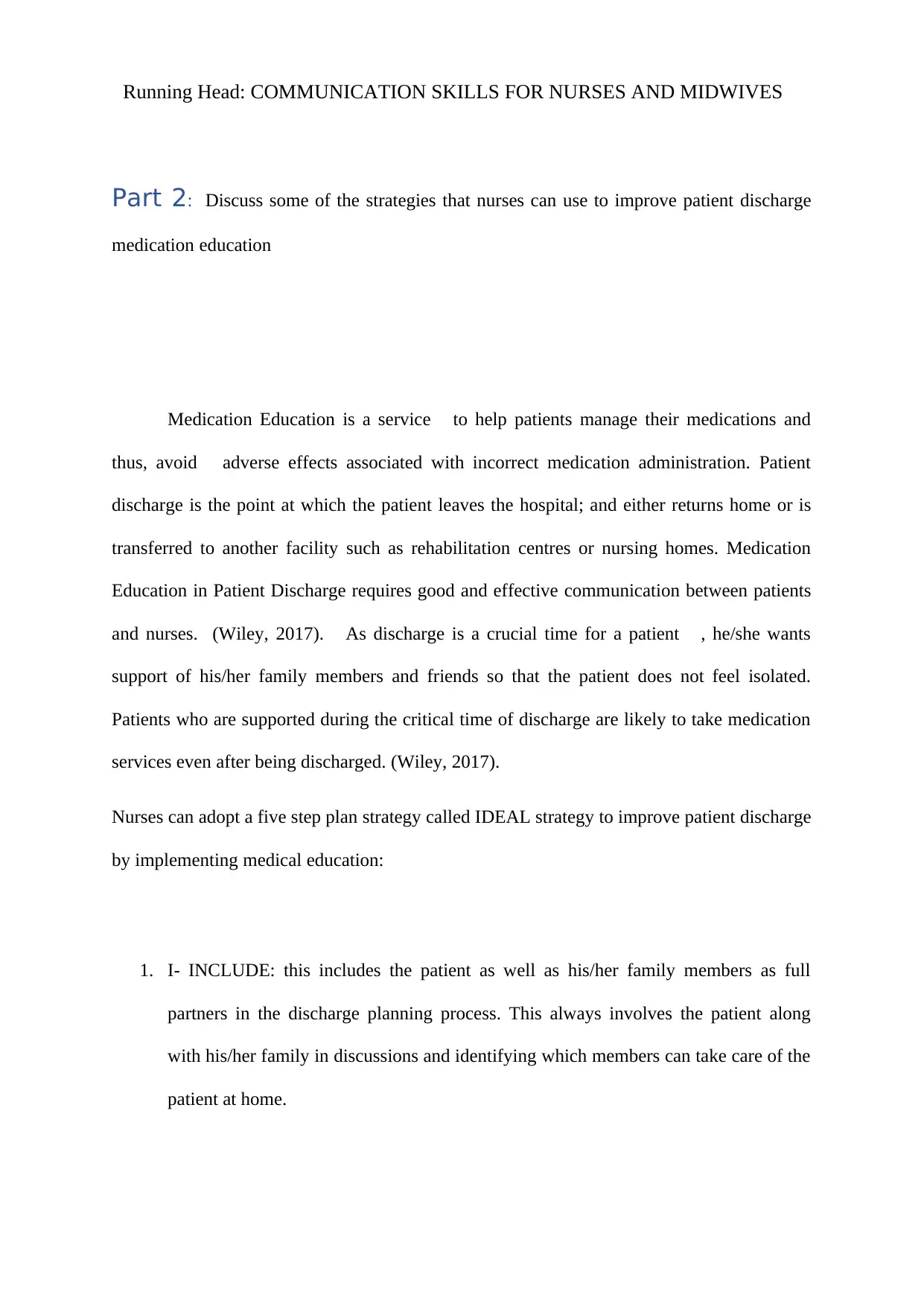
Running Head: COMMUNICATION SKILLS FOR NURSES AND MIDWIVES
Part 2: Discuss some of the strategies that nurses can use to improve patient discharge
medication education
Medication Education is a service to help patients manage their medications and
thus, avoid adverse effects associated with incorrect medication administration. Patient
discharge is the point at which the patient leaves the hospital; and either returns home or is
transferred to another facility such as rehabilitation centres or nursing homes. Medication
Education in Patient Discharge requires good and effective communication between patients
and nurses. (Wiley, 2017). As discharge is a crucial time for a patient , he/she wants
support of his/her family members and friends so that the patient does not feel isolated.
Patients who are supported during the critical time of discharge are likely to take medication
services even after being discharged. (Wiley, 2017).
Nurses can adopt a five step plan strategy called IDEAL strategy to improve patient discharge
by implementing medical education:
1. I- INCLUDE: this includes the patient as well as his/her family members as full
partners in the discharge planning process. This always involves the patient along
with his/her family in discussions and identifying which members can take care of the
patient at home.
Part 2: Discuss some of the strategies that nurses can use to improve patient discharge
medication education
Medication Education is a service to help patients manage their medications and
thus, avoid adverse effects associated with incorrect medication administration. Patient
discharge is the point at which the patient leaves the hospital; and either returns home or is
transferred to another facility such as rehabilitation centres or nursing homes. Medication
Education in Patient Discharge requires good and effective communication between patients
and nurses. (Wiley, 2017). As discharge is a crucial time for a patient , he/she wants
support of his/her family members and friends so that the patient does not feel isolated.
Patients who are supported during the critical time of discharge are likely to take medication
services even after being discharged. (Wiley, 2017).
Nurses can adopt a five step plan strategy called IDEAL strategy to improve patient discharge
by implementing medical education:
1. I- INCLUDE: this includes the patient as well as his/her family members as full
partners in the discharge planning process. This always involves the patient along
with his/her family in discussions and identifying which members can take care of the
patient at home.
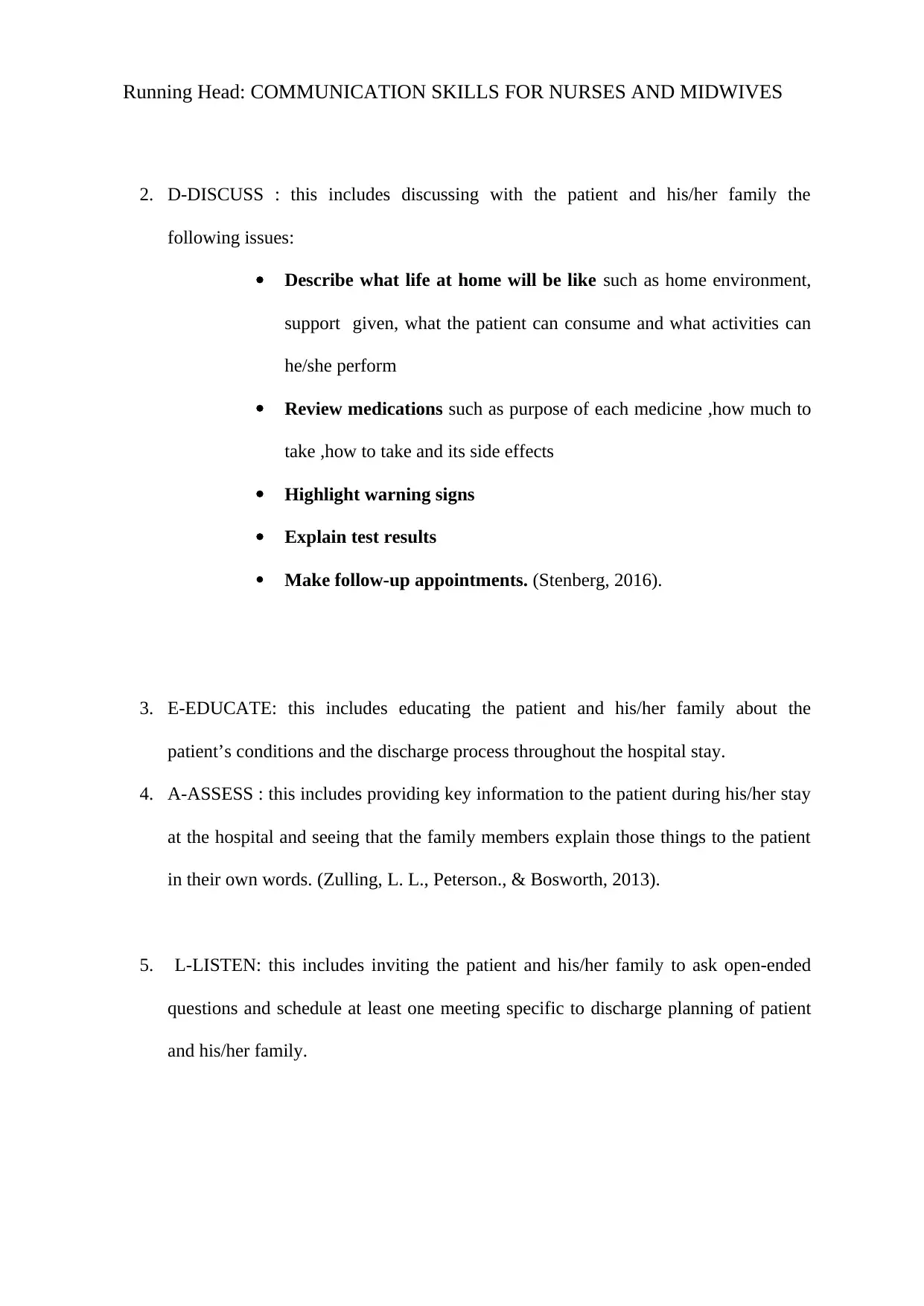
Running Head: COMMUNICATION SKILLS FOR NURSES AND MIDWIVES
2. D-DISCUSS : this includes discussing with the patient and his/her family the
following issues:
Describe what life at home will be like such as home environment,
support given, what the patient can consume and what activities can
he/she perform
Review medications such as purpose of each medicine ,how much to
take ,how to take and its side effects
Highlight warning signs
Explain test results
Make follow-up appointments. (Stenberg, 2016).
3. E-EDUCATE: this includes educating the patient and his/her family about the
patient’s conditions and the discharge process throughout the hospital stay.
4. A-ASSESS : this includes providing key information to the patient during his/her stay
at the hospital and seeing that the family members explain those things to the patient
in their own words. (Zulling, L. L., Peterson., & Bosworth, 2013).
5. L-LISTEN: this includes inviting the patient and his/her family to ask open-ended
questions and schedule at least one meeting specific to discharge planning of patient
and his/her family.
2. D-DISCUSS : this includes discussing with the patient and his/her family the
following issues:
Describe what life at home will be like such as home environment,
support given, what the patient can consume and what activities can
he/she perform
Review medications such as purpose of each medicine ,how much to
take ,how to take and its side effects
Highlight warning signs
Explain test results
Make follow-up appointments. (Stenberg, 2016).
3. E-EDUCATE: this includes educating the patient and his/her family about the
patient’s conditions and the discharge process throughout the hospital stay.
4. A-ASSESS : this includes providing key information to the patient during his/her stay
at the hospital and seeing that the family members explain those things to the patient
in their own words. (Zulling, L. L., Peterson., & Bosworth, 2013).
5. L-LISTEN: this includes inviting the patient and his/her family to ask open-ended
questions and schedule at least one meeting specific to discharge planning of patient
and his/her family.
⊘ This is a preview!⊘
Do you want full access?
Subscribe today to unlock all pages.

Trusted by 1+ million students worldwide
1 out of 6
Related Documents
Your All-in-One AI-Powered Toolkit for Academic Success.
+13062052269
info@desklib.com
Available 24*7 on WhatsApp / Email
![[object Object]](/_next/static/media/star-bottom.7253800d.svg)
Unlock your academic potential
Copyright © 2020–2025 A2Z Services. All Rights Reserved. Developed and managed by ZUCOL.




